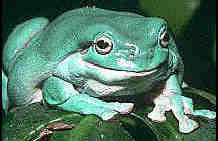It's funny looks have also brought about nicknames like "Dumpy Tree Frog" and "Smiling Frog."
It requires a really big and tall terrarium (recommended size is 25 gallon!!) with a lot of plants and hollow branches. There are two choices in tanks for the White's Tree Frog; the arboreal tank, or the terrestrial tank. The arboreal tank is the best choice because tree frogs spend most of their time high in the branches in their tank. The arboreal tank is normally two feet high; hexagon or pentagon shaped, and has a small base area. The terrestrial tank, however, is much shorter, and has a large base area.
Humidity should be moderate (Spraying the tank every now and then with
a spray bottle- make sure to dechlorinate the water and allow it to get a bit
stale etc.) Good ventialation is a must! (see the Frog
Doctor for details on illness prevention.)
Temperatures should be up to
86°F (30°C), but reduced to 68°F (20°C) at night.
The substrate you use in the bottom of your cage is very important. I've heard that Pine bark is the best choice. (Don't buy the fancy reptile bark you see in the store. It's too dusty, and the chips are dangerously small. White's often pick up a piece of bark when they're eating. If the bark is too small, they could accidentally swallow it and then die of indigestion. NEVER use cedar or pine shavings, gravel, or sand in your tank. The frogs can accidentally swallow some of these items and die.)
The water dish in your tank is another big issue. A dish that is six to eight inches long and wide, and four to five inches deep is perfect. White's like to spread out in the water and relax. As your frogs grow you'll have to get a bigger water dish.
Read more information on this subject in the Housing Your Pet Frog
section.
(For tips on cricket feeding, see my page on Dealing with Crickets for more info.)
They can now be found in all kinds of habitats, frequently near homes, around water tanks and cisterns. Breeding tends to only happen in pools of at least 12 inches of water in really huge terrariums or greenhouses. These frogs are known to live up to 21 years in captivity, 15 years is not uncommon. Their life span in the wild generally much shorter due to heavy predation.
One commonly asked question has to do with how to tell Male White's tree Frogs from Female ones. As far as I know this is pretty difficult to tell. First of all,the frog frog needs to be of "breeding" age to tell (about 1 year old). Males develop "nuptial pads" (puffy little pads on the place where their "thumbs" and "palms" meet) during the breeding season. I have heard from some that only males croak and sing also. Also, females tend to be larger than males, but bear in mind that size varies according to specific strains of White's tree frogs, so this is a pretty unreliable test.
 This picture was sent to me by my Froggy friend, Martin.
This picture was sent to me by my Froggy friend, Martin.
![]() 51KB WAV file Courtesy of Kenneth James Haase and his Kermit and Peabody Tree Frog site
51KB WAV file Courtesy of Kenneth James Haase and his Kermit and Peabody Tree Frog site
![]() 181KB WAV file Courtesy of Matthew J. Klueppel and The Complete Treefrog Home Page
181KB WAV file Courtesy of Matthew J. Klueppel and The Complete Treefrog Home Page
For more info, check out: